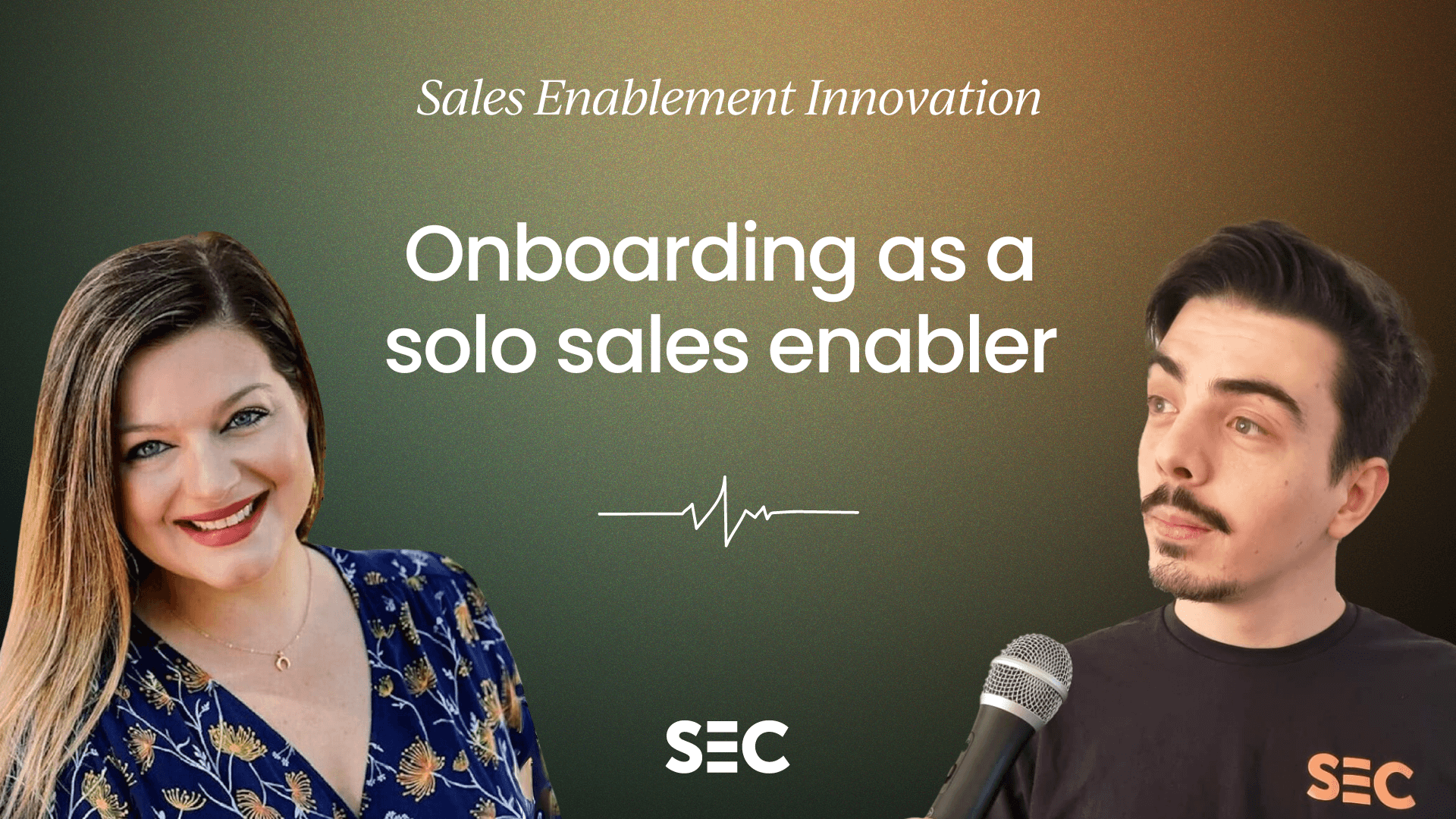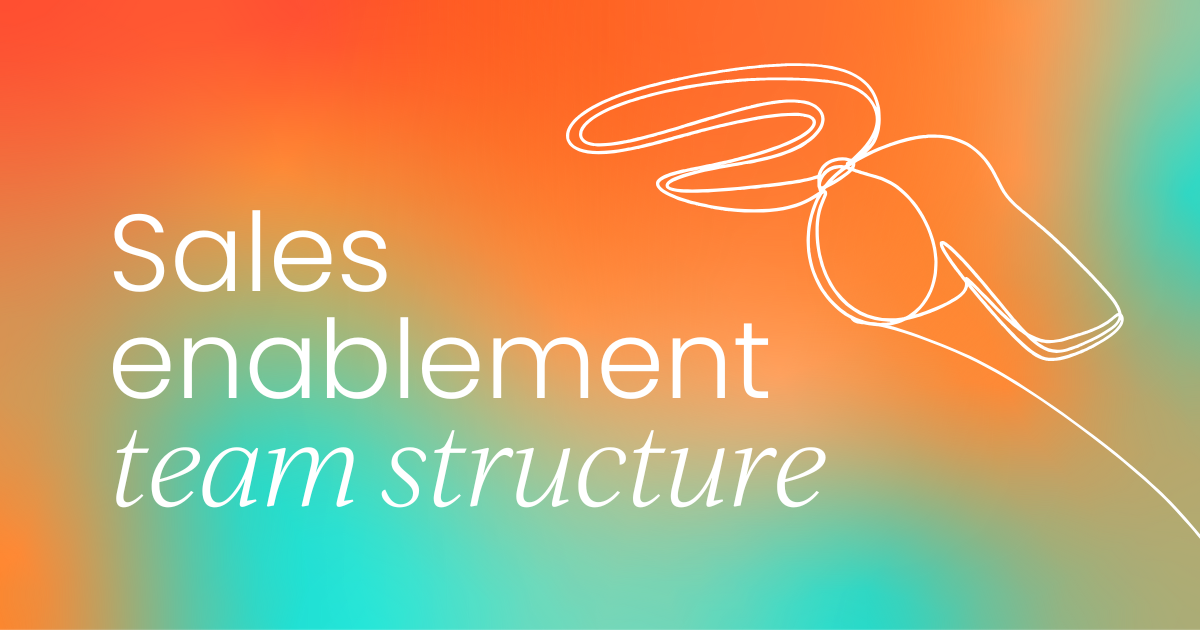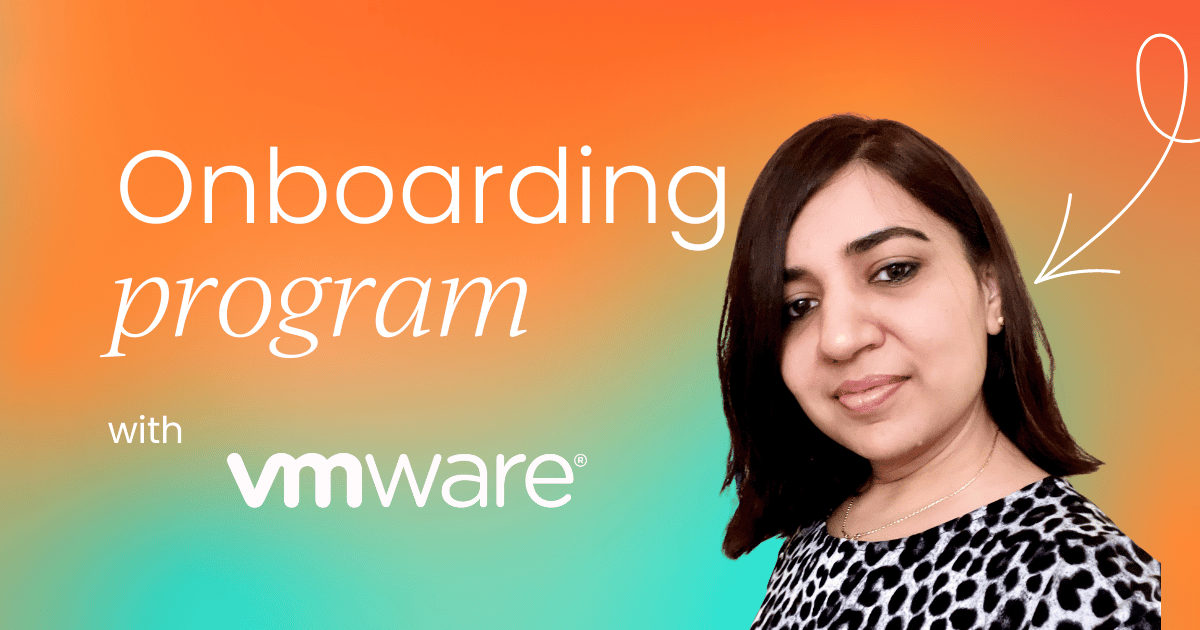The success and value of the sales enablement function within an organization is governed by a strong enablement charter that’s executed through a comprehensive offering of enablement programs, aligned to the revenue goals of the organization, and considers the specific needs of sales reps.
In order to be impactful, these enablement programs must be designed to allow sales teams and their leaders to develop the skills, knowledge, and tools they need to succeed in their roles.
Onboarding new sales reps is one of the primary areas of responsibility for B2B sales enablement teams. Onboarding is the first learning experience for a sales rep within the organization and sets the stage for their upcoming professional journey in the team, acting as a window into the general culture, expectations, and norms of the organization.
Therefore, the tone that’s set in this program and the content covered here become a crucial stepping-stone for the rep’s long-term success. A strong onboarding program is not only a key contributor to rep engagement, it also provides the foundation for quick ramp-up time and acts as a lever for high productivity and revenue growth.
There is no singular way of designing a successful sales onboarding program. Size of the organization, industry/domain it operates in, complexity of products/services it offers, competitive landscape, and its standing in the market, can all influence the structure, length, and depth of the program.
In addition, factors like: business needs, challenges of key stakeholders, skill level of new hires, and the timing/cadence/speed of your onboarding program, will determine how your onboarding program is conceptualized, designed, and deployed.
So if you have been tasked with designing (or redesigning) a sales onboarding program for your organization, this article provides a good starting point.
I'll cover:
- Key components of onboarding
- Best practices to build an impactful onboarding program
- How to measure success
Key components of onboarding
Let’s start by understanding the key components of a standard sales onboarding program.
Besides the standard HR basics (such as benefits, legal, payroll, health & safety, compliance, IT information, etc.), a sales onboarding program usually focuses on providing content and training in the following areas:
- An overview of the organization, its vision, mission, and cultural values.
- Details of its products, services, offerings, and capabilities, along with the high-level business strategy and goals for the given fiscal year.
- Key features, use cases, and differentiators for its products, coupled with the value proposition and supporting go-to-market motions.
- Profiles of target customer personas, their business needs, and challenges, supported by sales triggers.
- Competitive landscape for the organization, key competitors and their products, and information on overcoming common customer objections.
- Introduction to the sales methodology and its main components (this may be followed by separate, more detailed enablement that is purely focused on sales methodology).
- Overview of the standard sales process and the high-level steps to take at each stage of the sales cycle.
- Various sales tools used for deal management, quoting/pricing, prospecting, account planning, sales intelligence, sales analytics, sales acceleration, marketing automation, etc.
- Information about cross-functional teams and their role, such as product/customer marketing, sales operations, legal, deal management, competitive and market intelligence, customer success and support, partners, etc.
- Comprehensive list of resources, tools, and contacts to refer to for more information.
- Details of mandatory and optional post-onboarding training and learning opportunities.
This content is typically packaged into presentation slides and delivered over several days or weeks in an instructor-led format, which can either be virtual or in person.
In some organizations, all of this content is delivered asynchronously as web-based training, videos, etc., allowing new hires to review it at their own pace, but within a specified time limit.
Other organizations adopt a hybrid approach where they incorporate elements of both styles of learning and delivery in their onboarding program.
Best practices to build an impactful onboarding program
While there are many ways to structure and deliver a sales enablement program, there are several proven best practices that sales enablement professionals can follow to deliver a strong, engaging, and successful experience for new sales reps.
Allow for multi-modality learning experience
Many organizations put their new sales reps through several days or weeks of in-person sessions as part of their onboarding program (often called bootcamps).
While this approach works for some organizations, a singular modality learning experience doesn’t always lend itself well to long-term retention and recall of core concepts covered in the onboarding and thereby increases the ramp time.
It’s well-known that humans only retain 25% of new information they have learned by the end of the week, as evidenced by Ebbinghaus's Forgetting Curve.
To allow for a more immersive learning experience, it’s often a best practice to include elements of live learning (virtual or in-person) as well as self-guided learning (such as on-demand or self-paced learning) in the onboarding program.
Sections of your onboarding program that are: generally stable content, simple in nature, and don’t need to be updated often, can be designed into a self-paced format, such as eLearning, videos, articles, and job aids.
This self-guided portion can then be turned into pre-requisites (if the structure allows) for the live portion of onboarding. Aspects of onboarding that are more complex, require an expert, need in-depth discussion, are activity-based, or call for high levels of engagement are best delivered live.
This hybrid approach to designing an onboarding program caters to different learning styles and helps to avoid information fatigue, allowing the new reps to pace their learning and make progress based on their learning speed, especially as they’re drinking from the proverbial fire hose in their first few days as new hires.
This two-pronged approach also allows the onboarding program to be more scalable from an operational standpoint. When self-guided elements are turned into prerequisites, it becomes easier for the organization to stagger and consolidate the live portions of onboarding and be more flexible and agile with their delivery schedules.
Provide opportunities for real-time practice
Onboarding is not a one-way information street. Instead, they are an excellent avenue to set expectations, show new sales reps what good looks like, and have them emulate that in a safe training setting.
There are many ways to do this:
- Allow top sellers to talk about their experiences and engage with the new reps on what “good” looks like.
- Share a customer case study and build in scenario-based decision points around “what would you have done” at each stage of the sales cycle.
- Show the anatomy of a recent win/loss and use that as a discussion forum to identify key learning moments.
- Show an example of a product elevator pitch and have each sales rep build and present their own.
Hands-on activity-based exercises like this not only give sales reps the confidence to be successful in their new role, but also allow them to learn from the best sellers in your team, helping to increase their productivity.
Invite key department leaders
Another onboarding best practice is to incorporate live sessions that give new hires exposure to the various leaders in the organization.
This means bringing in the key leaders from the different departments as speakers and giving them an opportunity to share their role, strategic vision, priorities and challenges for their department, and measures of success.
This approach gives the new sales reps the opportunity to interact and build relationships with these critical stakeholders from the get-go and paves the way for cross-functional collaboration down the line.
Include role-based content
To maximize the relevance of content and allow for higher levels of engagement, another best practice is to structure the onboarding program so it accounts for role-based specificities.
This doesn’t mean that separate onboarding programs need to be delivered across separate roles, but it is more about structuring the onboarding content so that there is:
- Generalized content that is relevant to all roles and
- Tailored content that’s specific to individual roles.
A neat way of doing this is by following the 80/20 rule, which involves identifying and organizing 80% of the content that applies to all roles into the generalized content category.
The remaining 20% of content can be structured as role-specific content tied to the specific responsibilities, areas of function, core competencies, and skills for various roles.
The 80/20 approach results in a more streamlined and efficient onboarding process, maximizes content relevance for various roles, and enables high levels of on-the-job application of knowledge and skills learned during onboarding.
Supply an action plan
Onboarding is not a one-time activity. After completing their onboarding, new sales reps continue to learn and find their stronghold for several months before they are considered fully ramped.
To support their learning journey after onboarding, sales enablement professionals need to find ways to support sales reps to help accelerate their ramp-up time, reinforce the concepts learned during onboarding, and meet the identified core competencies for their role to match expected levels of productivity.
This can be easily accomplished by providing reps with a 90-day or a 120-day action plan that – at a weekly or a monthly level – clearly articulates the tasks they should be able to accomplish and the behaviors they should exhibit at each milestone.
This plan should be complete with links to additional enablement and training that reps can leverage to bridge the gaps in their core competency areas and skills.
Some sales enablement teams address this through a separate Competency and Skills Enablement program that builds on the knowledge and concepts taught during onboarding.
Ensure personalized post-onboarding support
Besides providing an action plan, sales enablers should also look to secure mentorship and coaching opportunities for new sales reps to nurture their post-onboarding learning journey.
This can be accomplished by pairing each new rep with a high-performing rep on the team to provide both dedicated and just-in-time support. Another alternative is to assign each new sales rep a first-line sales manager as a mentor for personalized coaching and guidance.
If there are opportunities for new reps to shadow existing team members or to engage in peer-to-peer learning with seasoned reps, those are also great ways of reducing their learning curve and increasing their productivity.
Make it fun
Besides ensuring a strong content structure and a multi-modality experience while providing action-oriented and personalized support, sales enablement pros should remember to make their onboarding program exciting and engaging for the sales reps.
Weaving in fun elements such as games, prizes, social events, and networking opportunities can help amplify the excitement of joining a new organization for new hires and enable them to immerse more seamlessly into the overall culture.
Creating cohorts within the onboarding program is another way of introducing a sense of kinship and camaraderie among the new hire groups and fostering shared learning experiences.
Build mechanisms for feedback
To ensure that the onboarding program is meeting the needs of new sales reps and to identify gaps and successes of the program promptly, it’s important to implement multiple feedback mechanisms throughout the program.
This can be done by:
- Surveying the new hires to get their feedback and opinions on what worked and what didn’t work. Surveys don’t have to be a one-time activity administered at the end of the onboarding program.
- Scheduling 1:1s or conducting focus groups with sales reps after onboarding to collect and discuss feedback.
- Talking to the managers of new sales reps to assess how well onboarding has supported the day-to-day role of the sales reps and translated into performance outcomes.
Continue to iterate
The world of sales is continually changing as our products and services evolve to respond to the needs of the market. The ever-shifting macro-level conditions and micro-level factors all demand our salesforce to be consistently dynamic and flexible in responding to the needs of customers.
A good onboarding program is therefore one that remains similarly adaptable, agile, and attuned to the constantly evolving needs of sellers. Sales enablers should periodically assess their onboarding program to understand what components are still relevant and what should be iterated upon.
Besides assessing and implementing the feedback received from the new reps, enablement pros should also conduct periodic reviews of their program against the established KPIs and measures of success to identify any gaps and pivots that may be needed.
Measuring the success of onboarding
In order to know whether your onboarding program is successful, it’s critical to have quantitative and qualitative measures in place that track the impact and effectiveness of the program.
This involves tracking metrics such as:
- Consistent rep performance: This is measured by time-to-milestone metrics such as time to first sale, time to second sale, time to third sale and beyond, and ability to consistently meet quota over time. This data provides a view into the clarity that new reps have about the activities and behaviors that they must master to consistently achieve their revenue goals.
- Enablement adoption rate: This measures how effectively the sales reps are consuming the enablement resources and tools provided to them. This can be tracked by site visits and clicks, file downloads, tool logins, sales content view stats, etc. This data can provide an indication of whether the sales enablement team is providing the right content and resources needed for reps’ long-term success.
- Satisfaction scores: Gathering satisfaction scores, content relevance ratings, and net promoter scores as part of the onboarding feedback process can provide a view into the gaps and successes of the onboarding program from the new sales reps’ standpoint.
Final Thoughts
The best sales enablement offerings aren't executed in isolation – each program should form the building blocks of a sales rep's knowledge and expertise.
Therefore, as you work to set up an onboarding program from scratch, don’t forget to assess other enablement programs that may already exist and those that may be in the process of being designed in parallel.
Onboarding is only the first step in a rep’s learning journey.
Their continued success is also shaped and influenced by other enablement offerings that they consume post-onboarding, such as competency and skills programs, sales methodology training & collateral, sales kick-off and other enablement events, just-in-time enablement, and more.
The collective impact of all your enablement offerings nurtures and strengthens your sellers and sets them up for long-term success in their roles.
Looking for more onboarding guidance?
Check out our Sales Onboarding Masters course, instructed by Arup Chakravarti, Director of Sales Excellence at Equifax UK.
By the end of this course, you’ll be able to...
- Build an onboarding process. Design an effective, scalable sales onboarding process from the ground up.
- Measure onboarding success. Use metrics, data, and analysis to track the success of your onboarding initiatives and develop improvements.
- Apply tested frameworks. Onboard new hires like an expert by using tried-and-tested frameworks and models to achieve success.


Sales enablement insider
Thank you for subscribing
Level up your sales enablement career & network with sales enablement experts
An email has been successfully sent to confirm your subscription.
 Follow us on LinkedIn
Follow us on LinkedIn


.png)
















